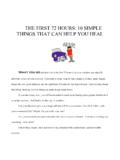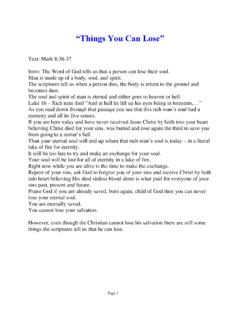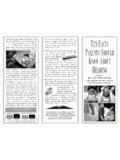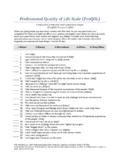Transcription of Things to know before you begin operating an NMR - MIT
1 Things to know before you begin operating an NMR. NMRs are expensive. They are delicate. Misusing or abusing them can cause thousands of dollars worth of damage. Most damage is avoidable, some is not. If you understand how the instrument works, you will also develop some feeling for why Things should be done a specific way. If, on the other hand, you do Things your own way and disregard normal procedure, you run the risk of damaging the instrument so that you and everyone else will not be able to use it for an extended period of time. Because of the danger posed by improper use of the instrument, those taking care of the NMRs often will revoke or severely curtail the access certain individuals have to NMR instrumentation.
2 This is simply the reality of NMR operation in a multi-user environment. Please keep this in mind if and when a DCIF Staff Member has a word with you about proper operating procedure. The DCIF Staff can and will limit your access if they feel it is needed. Basic Safety: NMR magnets are always live and always at field. They cannot be turned off like a light switch. Therefore, nothing ferromagnetic is allowed near them. This includes tools (hammers, wrenches, and screwdrivers), paper clips, staples, bobby pins, metal barrettes, costume jewelry, wallet chains, metal buckets, metal chairs, and floor buffers.
3 Items such as iPods, cell phones, and media storage devices can also be damaged by the magnetic field. ATM and credit cards will become unusable. Please leave all of these items in your lab or next to the instrument's computer when you approach the magnet. Liquid-state NMRs normally operate in the following manner: A sample is made up in an NMR tube. The sample typically consists of a solute and a solvent. The solvent is usually deuterated, meaning that is has deuterons in place of its protons. A proper amount ( to mL when using a 5mm diameter NMR tube) of the sample solution (solute and solvent) is placed in an NMR tube.
4 **DO NOT USE AN EPR TUBE OR ANY OTHER TUBE AS AN NMR TUBE**. Normal NMR tubes range in price from about a dollar per tube to more than $20 per tube. It is important to keep in mind that you get what you pay for. A cheap tube will often have a widely varying wall thickness, a varying outside diameter, or a pronounced bend or bow that will make it difficult to spin and shim. The more expensive the tube, the less likely it is that the tube can be blamed for poor results. Using an expensive NMR tube does not guarantee good results, but using a cheap NMR tube will often give problems with spinning, shimming, and hence with the line shapes you obtain, not to mention the possibility that you may break your tube (if it is badly warped) and contaminate the NMR probe with your sample.
5 Improper cleaning of NMR tubes can also render an expensive tube useless. Do NOT leave NMR. tubes in a drying oven for extended periods of time this causes the tubes to warp and flow under the force of gravity, thus making them non-cylindrical. The best way to clean a tube is to rinse it with appropriate solvents and finish with a couple of rinses of HPLC-grade acetone. 1. This final solvent rinse can be quickly expelled from the tube with either dry air, nitrogen, or argon blown through a drawn-out Pasteur pipet. If you want, you can also place the nearly-dry tube (don't start a fire!)
6 Flat in a glassware oven for ten minutes. Placing the correct amount of solvent in the NMR tube is important for a number of reasons. The most important reason is that the standard shims you use as a starting point for shimming on your particular sample assume that the solution meniscus is located at a certain position above the detected region of the sample. This means that with a normal amount of shimming, you will obtain better signal-to-noise if you use to mL of solvent, even if this means diluting your sample. In cases when the amount of the solute is limited, an extensive amount of shimming of the higher-order shims (z3, z4, z5, etc.)
7 Can compensate for the use of a smaller sample volume. That is, you have a choice: you can either spend more time shimming on a smaller volume of solution, or you can dilute your sample down to mL and spend all the time that you would have had to spend on shimming just collecting data instead. Informed individuals often choose the latter, but in some cases , those working with small amounts of natural products people actually do find it necessary to resort to non- standard shimming methods (pulsed field gradient shimming), special NMR tubes ( , Shigemi tubes), or even special NMR probes ( , Varian nanoprobes).
8 The NMR tube must be positioned properly in a spinner (See Figure 1) before it can be introduced into the NMR instrument. A spinner is usually a piece of kel-F or some other polymer with some gripping mechanism ( , a rubber band or a rubber o-ring) to hold the tube securely in place. before the tube is inserted into the spinner, it should be thoroughly wiped off with a clean Kim-wipe or equivalent. Failure to wipe off grease and other chemicals off of the outside of the NMR tube will contaminate the spinner and may even cause the spinner to fail to grip the tube properly.
9 WIPING OFF THE TUBE IS. VERY IMPORTANT. Figure 1. 2. If the NMR tube slides up and down too easily in the spinner, then somebody has already contaminated the spinner (or it is old). If you notice that the tube slides up and down too easily, then you should either clean the spinner, use another spinner, or ask a DCIF Staff Member to help you clean or replace the spinner. If the tube slides down too far upon insertion into the magnet, bad Things can happen (broken probe, broken sample, impossible to shim by hand). The NMR tube needs to be positioned in the spinner so that your solution is in the detected region of the NMR probe once the spinner is in place.
10 The tube should never exceed the maximum allowable sample depth for the NMR probe that is inside the magnet. Exceeding the maximum allowed sample depth can break sample or probe or both. That is, the tube should not stick down so far that it hits a part of the probe that it is not supposed to touch. The sample depth gauge should contain information on what the maximum allowable sample depth is for a specific type of NMR probe (the maximum depth is usually only a function of the diameter of the NMR tube that the probe is designed to accommodate). Another important consideration to keep in mind when positioning one's sample tube in the spinner is that the bottom of the NMR tube and the solution meniscus at the top should be equidistant from the center of the detected region (see Figure 2).
















